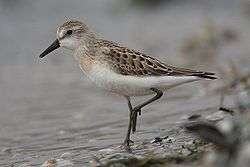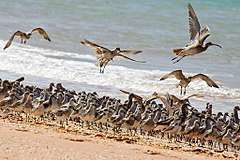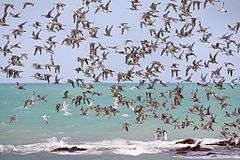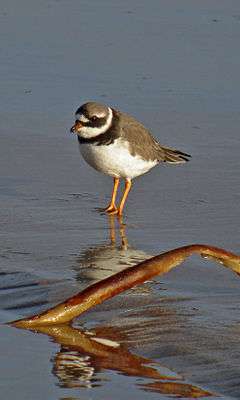Wader
Waders or shorebirds are birds of the order Charadriiformes commonly found along shorelines and mudflats that wade in order to forage for food (such as insects or crustaceans) in the mud or sand. The term "wader" is used in much of the world, while "shorebird" is used in North America, where "wader" may be used instead to refer to long-legged wading birds such as storks and herons.
| Waders Temporal range: Late Oligocene to recent | |
|---|---|
 | |
| Semipalmated sandpiper (Calidris pusilla) | |
| Scientific classification | |
| Kingdom: | |
| Phylum: | |
| Class: | |
| Order: | Charadriiformes (partim) |
| Suborders | |



There are about 210[1] species of wader, most of which live in wetland or coastal environments. Many species of Arctic and temperate regions are strongly migratory, but tropical birds are often resident, or move only in response to rainfall patterns. Some of the Arctic species, such as the little stint, are amongst the longest distance migrants, spending the non-breeding season in the southern hemisphere.
Many of the smaller species found in coastal habitats, particularly but not exclusively the calidrids, are often named as "sandpipers", but this term does not have a strict meaning, since the upland sandpiper is a grassland species.
The smallest member of this group is the least sandpiper, small adults of which can weigh as little as 15.5 grams and measure just over 13 centimetres (5 inches). The largest species is believed to be the Far Eastern curlew, at about 63 cm (25 in) and 860 grams (1 pound 14 ounces), although the beach thick-knee is the heaviest at about 1 kg (2 lb 3 oz).
In the Sibley-Ahlquist taxonomy, waders and many other groups are subsumed into a greatly enlarged order Ciconiiformes. However, the classification of the Charadriiformes is one of the weakest points of the Sibley-Ahlquist taxonomy, as DNA–DNA hybridization has turned out to be incapable of properly resolving the interrelationships of the group. Formerly, the waders were united in a single suborder Charadrii, but this has turned out to be a "wastebasket taxon", uniting no less than four charadriiform lineages in a paraphyletic assemblage. However, it indicated that the plains wanderer actually belonged into one of them. Following recent studies (Ericson et al., 2003; Paton et al., 2003; Thomas et al., 2004a, b; van Tuinen et al., 2004; Paton & Baker, 2006), the waders may be more accurately subdivided as follows:
- Suborder Scolopaci
- Family Scolopacidae: snipe, sandpipers, phalaropes, and allies
- Suborder Thinocori
- Family Rostratulidae: painted snipe
- Family Jacanidae: jacanas
- Genus †Hakawai
- Family Thinocoridae: seedsnipe
- Family Pedionomidae: plains wanderer
- Suborder Chionidi
- Family Burhinidae: thick-knees
- Family Chionididae: sheathbills
- Family Pluvianellidae: Magellanic plover
- Suborder Charadrii
- Genus †Cherevychnavis
- Genus †Neilus
- Family Ibidorhynchidae: ibisbill
- Family Recurvirostridae: avocets and stilts
- Family Haematopodidae: oystercatchers
- Family Charadriidae: plovers and lapwings
In keeping more in line with the traditional grouping, the Thinocori could be included in the Scolopaci, and the Chionidi in the Charadrii. However, the increasing knowledge about the early evolutionary history of modern birds suggests that the assumption of Paton et al. (2003) and Thomas et al. (2004b) of 4 distinct "wader" lineages (= suborders) already being present around the Cretaceous–Paleogene boundary is correct.
Characteristics
Shorebirds is a blanket term used to refer to multiple bird species that live in wet, coastal environments. Because most these species spend much of their time near bodies of water, many have long legs suitable for wading (hence the name ‘Waders’). Some species prefer locations with rocks or mud. Many shorebirds display migratory patterns and often migrate before breeding season. These behaviors explain the long wing lengths observed in species, and can also account for the efficient metabolisms that give the birds energy during long migrations.[2]
The majority of species eat small invertebrates picked out of mud or exposed soil. Different lengths of bills enable different species to feed in the same habitat, particularly on the coast, without direct competition for food. Many waders have sensitive nerve endings at the end of their bills which enable them to detect prey items hidden in mud or soft soil. Some larger species, particularly those adapted to drier habitats will take larger prey including insects and small reptiles.
Sexual dimorphism
Shorebirds, like many other animals, exhibit phenotypic differences between males and females, also known as sexual dimorphism. In shorebirds, various sexual dimorphisms are seen, including, but not limited to, size (e.g. body size, bill size), color, and agility. In polygynous species, where one male individual mates with multiple female partners over his lifetime, dimorphisms tend to be more diverse.[2] In monogamous species, where male individuals mate with a single female partner, males typically do not have distinctive dimorphic characteristics such as colored feathers, but they still tend to be larger in size compared to females. The suborder Charadrii displays the widest range of sexual dimorphisms seen in the order Charadriiformes.[3] However, cases of sexual monomorphism, where there are no distinguishing physical features besides external genitalia, are also seen in this order.[4]
Sexual selection
One of the biggest factors that leads to the development of sexual dimorphism in shorebirds is sexual selection.[5] Males with ideal characteristics favored by females are more likely to reproduce and pass on their genetic information to their offspring better than the males who lack such characteristics. Mentioned earlier, male shorebirds are typically larger in size compared to their female counterparts. Competition between males tends to lead to sexual selection toward larger males and as a result, an increase in dimorphism. Bigger males tend to have greater access (and appeal) to female mates because their larger size aids them in defeating other competitors.[5] Likewise, if the species exhibits gender role reversal (where males take on roles traditionally done by females such as childcare and feeding), then males will select female mates based on traits that are the most appealing. In the Jacana species, females compete with each other for access to male mates, so females are larger in size. Males choose female mates based on who presents herself as the strongest and who 'owns' the most territory.[4]
Natural selection
Another factor that leads to the development of dimorphisms in species is natural selection. Natural selection focuses on traits and the environment's response to the traits in question; if the said trait increases the overall fitness of the individual possessing it, then it will be 'selected' and eventually become a permanent part of the population's gene pool. For example, depending on the food available in a shorebird specie's respective niche, bigger bill sizes may be favored in all individuals.[5] This would essentially lead to monomorphism within the species but is subject to change once sexual selection acts on the trait. Sexual selection could give rise to males with relatively larger bills than females if males used their bills to compete with other males. If larger bill size assisted the male in gathering resources, it would also make him more attractive to female mates.[2]
References
- G.C. Boere, C.A. Galbraith and D.A. Stroud (2006). "Waterbirds around the world" (PDF). Joint Nature Conservation Committee.
- "Explore the World With Shorebirds." U.S. Fish and Wildlife Service, 1 Aug. 2004. Web.<http://www.fws.gov/alaska/external/education/pdf/Chap4.pdf>.
- Székely, Tamás, John D. Reynolds, and Jordi Figuerola. 2000. Sexual Size Dimorphism In Shorebirds, Gulls, And Alcids: The Influence Of Sexual And Natural Selection. 54(4): 1404-413.
- Lindenfors, P., T. Szekely, and J. D. Reynolds. "Directional Changes in Sexual Size Dimorphism in Shorebirds, Gulls and Alcids." Journal of Evolutionary Biology J. Evolution Biol: 930-38. Print.
- Szekely, T., R. P. Freckleton, and J. D. Reynolds. "Sexual Selection Explains Rensch's Rule of Size Dimorphism in Shorebirds." Proceedings of the National Academy of Sciences (2004): 12224-2227. Print.
Sources
- Ericson, P. G. P.; Envall, I.; Irestedt, M.; & Norman, J. A. (2003). Inter-familial relationships of the shorebirds (Aves: Charadriiformes) based on nuclear DNA sequence data. BMC Evol. Biol. 3: 16. doi:10.1186/1471-2148-3-16 PDF fulltext
- Pandiyan, J. and S. Asokan. 2015. Habitat use of pattern of tidal mud and sandflats by shorebirds (charadriiformes) Wintering in southern India. Coastal Conservation https://doi.org/10.1007/s11852-015-0413-9.
- Paton, Tara A.; & Baker, Allan J. (2006). Sequences from 14 mitochondrial genes provide a well-supported phylogeny of the Charadriiform birds congruent with the nuclear RAG-1 tree. Molecular Phylogenetics and Evolution 39(3): 657–667. doi:10.1016/j.ympev.2006.01.011 PMID 16531074 (HTML abstract)
- Paton, T. A.; Baker, A. J.; Groth, J. G.; & Barrowclough, G. F. (2003). RAG-1 sequences resolve phylogenetic relationships within charadriiform birds. Molecular Phylogenetics and Evolution 29: 268–278. doi:10.1016/S1055-7903(03)00098-8 PMID 13678682 (HTML abstract)
- Thomas, Gavin H.; Wills, Matthew A. & Székely, Tamás (2004a). Phylogeny of shorebirds, gulls, and alcids (Aves: Charadrii) from the cytochrome-b gene: parsimony, Bayesian inference, minimum evolution, and quartet puzzling. Molecular Phylogenetics and Evolution 30(3): 516–526. doi:10.1016/S1055-7903(03)00222-7 (HTML abstract)
- Thomas, Gavin H.; Wills, Matthew A.; & Székely, Tamás (2004b). A supertree approach to shorebird phylogeny. BMC Evol. Biol. 4: 28. doi:10.1186/1471-2148-4-28 PMID 15329156 PDF fulltext Supplementary Material
- van Tuinen, Marcel; Waterhouse, David; & Dyke, Gareth J. (2004). Avian molecular systematics on the rebound: a fresh look at modern shorebird phylogenetic relationships. Journal of Avian Biology 35(3): 191–194. PDF fulltext
- Explore the World With Shorebirds. (2004). U.S. Fish and Wildlife Service. Web. http://digitalmedia.fws.gov/cdm/ref/collection/document/id/1598
- Lindenfors, P.; Szekely, T.; and Reynolds, J. D. (2003). Directional Changes in Sexual Size Dimorphism in Shorebirds, Gulls and Alcids. Journal of Evolutionary Biology J Evolution Biol: 930–38. Print.
- Szekely, T.; Freckleton, R.; & Reynolds, J. (2004). Sexual selection explains Rensch's rule of size dimorphism in shorebirds. Proceedings of the National Academy of Sciences. 101(33): 12224–12227.
- Szekely, Tamas; John D. Reynolds; and Jordi Figuerola. (2000) Sexual Size Dimorphism in Shorebirds, Gulls, and Alcids: The Influence of Sexual and Natural Selection. Evolution 54(4): 1404–413.
External links
